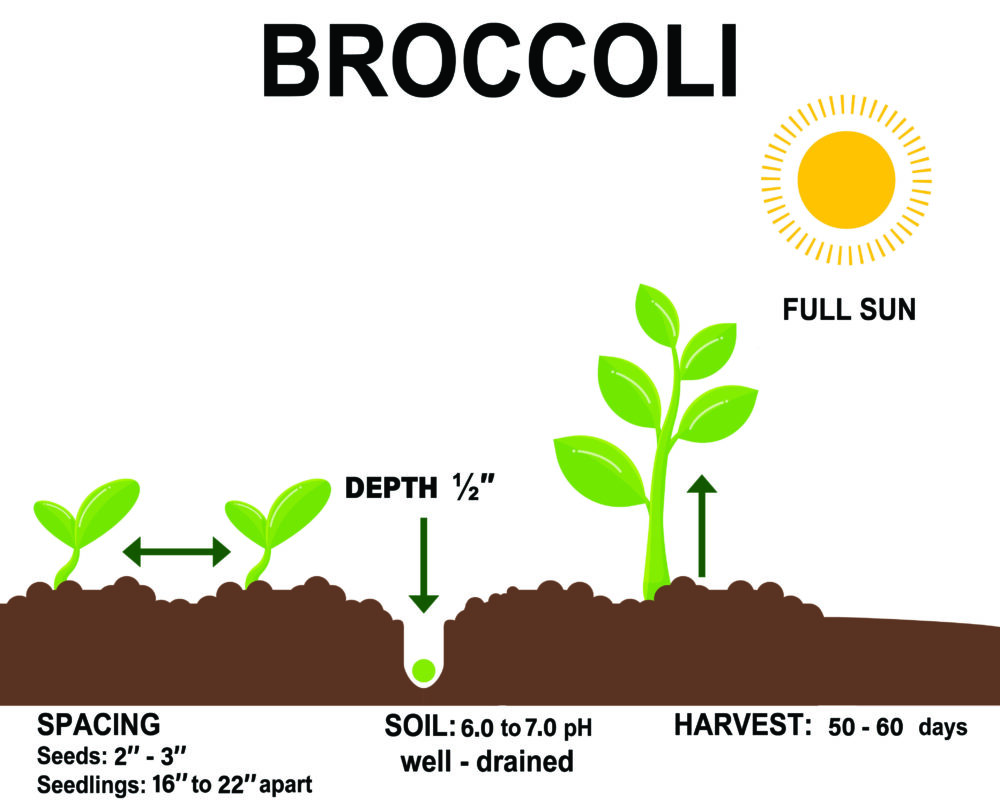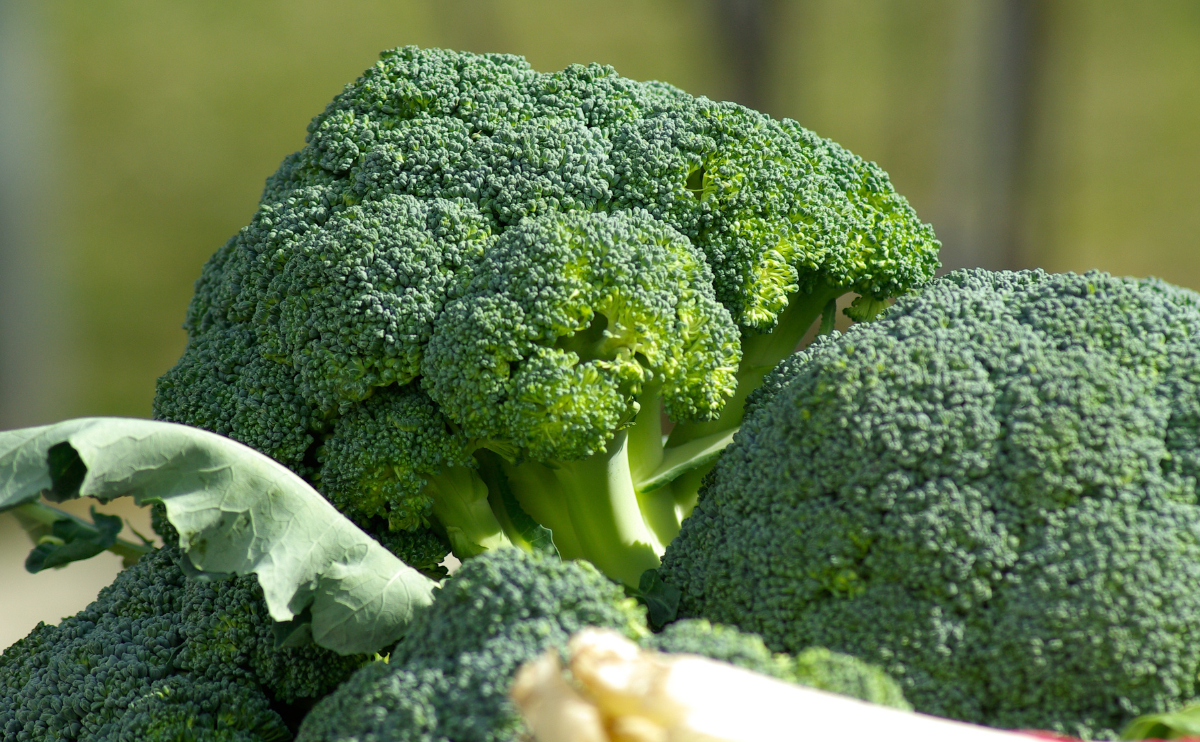Broccoli is a stout, thick-stemmed plant in the Brassicaceae family, which also includes cabbage, kale, and Brussels sprouts. Large, blue-gray leaves are leathery and oblong, arranged around an upright trunk-like structure that supports a flowering head. The part we eat is actually the buds of the broccoli flower. If left unharvested, the broccoli head would open into small greenish-yellow flowers. Although most broccoli is green, there are also some delicious and beautiful purple varieties.
Broccoli has a moderate growth rate. It is typically planted in the early to mid-spring for an early summer harvest. And in warm climates, a late summer planting can yield a fall harvest.

| Common Name | Broccoli |
| Botanical Name | Brassica oleracea var. italica |
| Family | Brassicaceae |
| Plant Type | Biennial, annual, vegetable |
| Size | 18–30 in. tall, 12–24 in. wide |
| Sun Exposure | Full sun |
| Soil Type | Moist, loamy, well-drained |
| Soil pH | Acidic, neutral |
| Hardiness Zones | 2–11 (USDA) |
| Native Area | Mediterranean, Asia |

When to Plant?
This will be determined by your planting zone. There is a final frost date for each area. As a result, you can plan your gardening activities around this date. Check our Frost Dates Across North America: First & Last Frost Dates Chart. However, the date will not be the same for every plant.
How to Plant
Planting broccoli seeds should be done in late spring or summer to allow plants to mature in fall temperatures. For spring sowing, seeds are started indoors 7 – 9 weeks before the last frost’s average date. For fall crops, start sowing indoors about ten weeks before the first fall frost. Sow seeds up to ½ inch deep.
The seeds should germinate in 5 – 10 days at 65°F – 75°F. Transplant seedlings into the garden when they are 4 to 6 inches tall. Broccoli is best grown in full sun, but it thrives in partial shade.
Broccoli requires exposure to full sun from 6 to 8 hours a day. Otherwise, the lack of sunlight will produce thin, long-legged plants and subpar heads.
Before you transplant broccoli into your garden, add 3 – 4 inches of compost and well-aged manure to your planting bed. Growing broccoli requires moisture-retaining, loose soil. The ideal plant spacing for broccoli is 16 to 22 inches. Spread rows 36 inches apart. The pH of the soil should be between 6.0 and 7.0.

How to Cultivate
Water – Provide consistent soil moisture with regular watering, especially in drought conditions. Water at least 1 to 1 ½ inch per week. Do not get developing broccoli heads wet when watering, as it can encourage rot. Smother weeds with mulch. Mulching around plants will also help to reduce the soil temperature.
Fertilize with an organic fertilizer such as fish emulsion.
Soil – 6.0 to 7.0 pH, well-drained
Spacing – seeds – 2″ – 3″
Seedling – 16″ – 22″
Seed life: 3 years
Sun: Full sun
Germination: 4 – 7 days, 45°F – 85°F
Day to Harvest: 50 – 60 days
How to Harvest
It would be best if you harvested broccoli in the morning to make sure the heads stay crispy and dense and store longer.
If you see yellow petals, urgently harvest the crop, as its quality will decrease quickly.
Cut off the heads of the plant, taking at least 6 inches of stem. Oblique cutting should be performed so that the water can drain off the stem.
Hydroponics
Germination: Soak broccoli seeds in water for 12-24 hours to improve germination rates. Place the seeds in a growing medium, such as rockwool cubes, and keep them moist until they germinate. Once the seedlings have emerged, transfer them to the hydroponic system.
pH range: Broccoli prefers a slightly acidic to neutral pH range of 6.0-7.5. Test the pH level of the nutrient solution regularly and adjust it accordingly using pH up or pH down solutions.
EC: The electrical conductivity (EC) of the nutrient solution should be between 1.5-2.5 mS/cm for broccoli. Monitor the EC level regularly using a digital meter and adjust it by adding or reducing nutrient solution.
PPM: The recommended parts per million (PPM) range for broccoli is between 800-1800 ppm. Check the PPM level of the nutrient solution frequently and adjust it by adding or reducing nutrients as needed.
Humidity: Broccoli requires moderate to high humidity levels between 50-80%. Maintain proper humidity levels by using a humidifier or misting system if necessary.
Light hours: Broccoli requires at least 14-16 hours of light per day to grow properly. Use full-spectrum LED grow lights that mimic natural sunlight for optimal growth.
Temperature air: Broccoli prefers cool air temperatures between 60-70°F (15-21°C) during the day and slightly cooler temperatures between 50-60°F (10-15°C) at night. Monitor the temperature using a thermometer and maintain it by using a heater or air conditioning system as needed.
Temperature water: The ideal water temperature for broccoli is between 60-70°F (15-21°C). Use a water chiller or heater to regulate the water temperature and ensure it remains within the appropriate range.
By following these guidelines, you should be able to successfully grow broccoli hydroponically. Good luck!



